| Pages:
1
2 |
watson.fawkes
International Hazard
    
Posts: 2793
Registered: 16-8-2008
Member Is Offline
Mood: No Mood
|
|
Quote: Originally posted by blogfast25  | This strongly points to something in the pewter being dissolved ate the end of the dissolution process and forming a green compound. But
what?
|
Bismuth and cadmium are both candidates for minor components in pewter tin alloys. They're both used in
such formulations.
|
|
|
blogfast25
International Hazard
    
Posts: 10562
Registered: 3-2-2008
Location: Neverland
Member Is Offline
Mood: No Mood
|
|
They are but do they do any of the following?
Today I made some more K2SnCl6, this time using HCl that is essentially Fe free (previously I thought the strange colours might be due to it).
Well, here’s the pewter, nearly completely dissolved in the HCl:
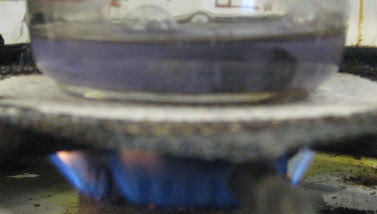
The solution is a strange amethysty colour…
After adding the nitric and some simmering to mop up any residue and oxidise the Sn (II) to Sn (IV) the solution clears up completely and turns green.
The intensity of the green is very similar to that obtained with the Fe-containing HCl:
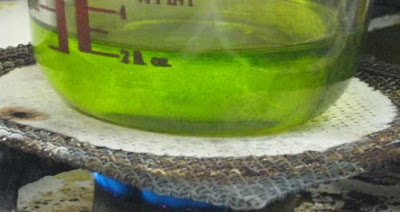
So it would appear that some moiety is blueish-purple prior to oxidation then turns green upon oxidation… It could be a decent redox indicator if I
knew what it was!
Here’s the end product: first crop of K2SnCl6 crystals obtained simply by allowing the solution, after addition of KCl, to cool down:
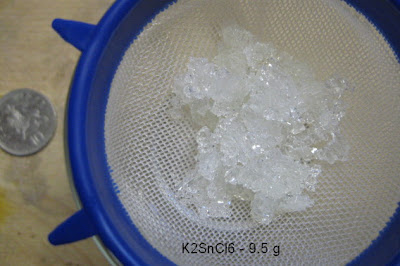
The second crop was obtained by reducing the supernatant liquor from 4 cups to 3 cups, it was much larger.
K2SnCl6 is more soluble in water and strong HCl than I anticipated: adding cold, saturated KCl solution to a cold, previously oxidised pewter solution
(contains SnCl4, or SnCl6 (2-)) yields no precipitate at all. Only further reducing this solution causes potassium hexachlorostannate to crystallise
out.
The salt also dissolves in water, into a clear solution that sheds Sn(OH)4 on heating and on adding NH3 solution, both precipitates dissolve back into
HCl…
|
|
|
blogfast25
International Hazard
    
Posts: 10562
Registered: 3-2-2008
Location: Neverland
Member Is Offline
Mood: No Mood
|
|
Sn content of homemade (NH4)2SnCl6
250 ml of KMnO4 0.1 N were prepared and standardised against a primary standard of fresh 0.1 N oxalic acid according to the following procedure
(*.pdf):
http://goes.flexinet.com.au/download/chem12/exp/redoxEXP5.pd...
About 5 g of homemade (NH4)2SnCl6, already quite dry from drying with CaCl2, were dried in an electric oven at 70 C, until weight was constant. During
drying a faint smell of NH4Cl could be observed. Excess NH4Cl sublimating or (NH4)2SnCl6 decomposing?
4.63 g of the dried product was then dissolved in 100 ml of 22 % HCl in a 500 ml conical flask, with cautious warming to help dissolution. 1.1 g of Al
was then added to reduce the Sn (IV) to Sn2+, the solution then simmered to flush out any residual hydrogen and cooled. It was then quantitatively
transferred into a 250.0 ml measuring flask and diluted to the mark with 1 M HCl.
This solution (20.0 ml) was then titrated thrice with the standardised KMnO4. The three titrations were in excellent agreement. The Sn content of the
4.63 g sample was then calculated to be 32.2 w%. Theoretically the Sn content of pure (NH4)2SnCl6 is 34.0 w%. So
quite good agreement considering the homemade product was made from technical grade ingredients (including quite horrible homemade NH4Cl) and hadn’t
even been recrystallised once.
But there was also a strange ‘incident’. When I added the crystals of the ammonium hexachlorostannate to the conical flask, a strange ping
discolouration beset much of the crystals:

The Erlenmeyer is a used one but clean and in good condition, the last liquid in it was DIW. In Dutch, ammonium hexachlorostannate is known as
'pink salt' although it isn't clear whether this is a reference to colour...
On adding the 100 ml of 22 % HCl and dissolving the pink immediately disappeared.
During reaction of the Al with the hot acid:
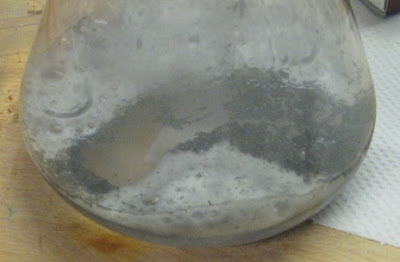
I can’t help but thinking that the blackish residue that temporarily forms may be elemental tin (plated out), which then redissolves in the hot HCl
to SnCl2. On the older tin salts thread someone claims the same. For all my experiments with tin I do have a stainless steel teapoon plated with tin
metal, no kidding...
After the reduction with Al/H2:
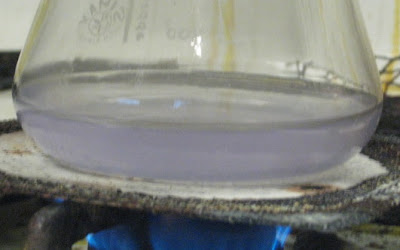
The solution turns purple (it’s also ever so slightly turbid), reminiscent of the colour of pewter solutions prior to oxidation…
The K2SnCl6 will be assayed for Sn in the same way…
[Edited on 13-11-2010 by blogfast25]
|
|
|
blogfast25
International Hazard
    
Posts: 10562
Registered: 3-2-2008
Location: Neverland
Member Is Offline
Mood: No Mood
|
|
For non-recrystallised homemade K2SnCl6 and using the procedure above, I found the Sn content to be 30.8 w%, for a theor. value of
29.0 w%. Not a bad correspondence at all...
It would appear also the the solubility of (NH4)2SnCl6 at BP in azeotropic HCl is approx. 20 - 25 g per 100 g of solvent. Solubility then drops
sharply towards RT...
[Edited on 14-11-2010 by blogfast25]
|
|
|
blogfast25
International Hazard
    
Posts: 10562
Registered: 3-2-2008
Location: Neverland
Member Is Offline
Mood: No Mood
|
|
Some tests with allegedly pure tin (99.9 %). About 2.5 g about to face the acid:
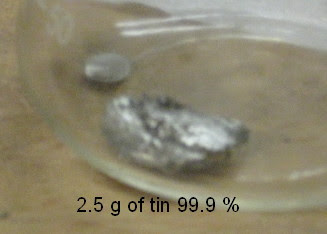
During dissolution – the amethysty colour shows up. Is this coming from the acid or from the tin?
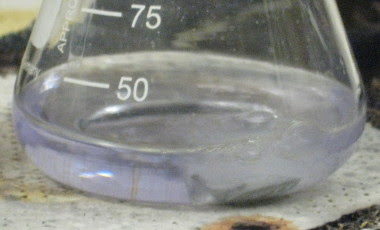
At the end of the dissolution, nitric acid was added to oxidise Sn (II) to Sn (IV): the colour changes to yellow. This is taken after ammonium
chloride was added and during simmering down:
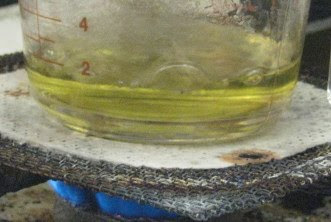
|
|
|
blogfast25
International Hazard
    
Posts: 10562
Registered: 3-2-2008
Location: Neverland
Member Is Offline
Mood: No Mood
|
|
A few more observations.
(NH4)2SnCl6 seems thermally fairly stable: the dry product heated at 150 C for 1 hour lost no weight (it actually gained a little) and remained as
soluble in water as ever before.
But glowing a dry mixture of the product with about the same amount of NH4Cl (well mixed) in test tube, caused all of the product to sublime off with
the NH4Cl, with no insoluble residue left behind.
Mixing the product with conc. H2SO4 (well, 95 %) did not yield any SnCl4 unlike (NH4)2PbCl6 which does yield PbCl4 when cold conc. H2SO4 is added.
Here, some fizzing starts at RT and intensifies at higher temperature. Presumably: (NH4)2SnCl6 + 2 H2SO4 2 NH4Cl + Sn(SO4)2 + 4 HCl
|
|
|
blogfast25
International Hazard
    
Posts: 10562
Registered: 3-2-2008
Location: Neverland
Member Is Offline
Mood: No Mood
|
|
Another observation is that dissolving the aluminium I use to carry out reductions in strong HCl leads also to a permanent light amethyst colour of
the resulting solution.
So pewter, fairly pure tin and ‘my’ aluminium all show this colour. It’s extremely reminiscent of dilute solutions of Ti (III) or chromium alum
but these can hardly be responsible…
And I’ve still not been able to show conclusively that the tankard pewter contains antimony. If it does then the pewter-based (NH4)2SnCl6 and
K2SnCl6 almost certainly contains some NH4SbCl6 and KSbCl6 respectively.
Tin and antimony are remarkably similar despite different valences.
Any ideas for a preferably quick, easy and colourful (but not spectral) test for Sb, I'd be very interested...
|
|
|
| Pages:
1
2 |